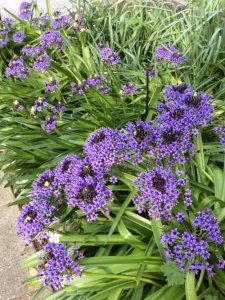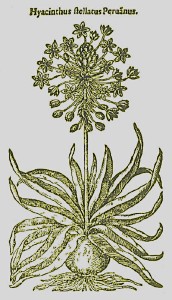By Seán A. O’Hara
Scilla peruviana is a common bulb here in California, often shared among gardeners because of its horticultural ease and tendency to multiple and self-seed. I’ve met many gardeners who have grown it for years but had no idea what it actually was! Fully adapted to the mediterranean climate, during the dry season it goes completely dormant and is often forgotten about until a new set of leaves emerge with the fall rains. Typically, cultivated plants have rich blue flowers, though a pure white form is often sold.

of S. peruviana
This variant can produce white seedlings, but more often – especially if blue plants are close at hand, it crosses yielding various colored forms from pale blue to dark blue and even lavenders. Sometimes there is a different hue on the petal, the stamens, as well as the conspicuous pistil, making for a multiplicity of color arrangements.
This is exactly what I encountered years ago when I was hired to consult on a very old garden in Berkeley. These bulbs had seeded themselves around much of the large garden during many years of neglect (i.e. there was no one to remove the numerous seed-heads which formed after flowering). I still have a small selection of different types that I’ve grown since. Because each 10″-12″ flower spike can produce as many as 150 individual flowers, it makes a month-long display, but there can also be a copious amount of seed produced.
 The fact that it does so well under our local mediterranean climate conditions is no surprise. Contrary to the scientific name, S. peruviana‘s range is from Tunisia to Morocco, Portugal, southern Spain, and Italy. In this last country, it has become increasingly rare, even though there is evidence that it could have been already under cultivation in ancient gardens in Sicily. Naturalization has occurred in other parts of the Mediterranean and even the world. It has become so common in Cuba, many people now call this the “Cuban Lily” with many new cultivars of the species bearing Caribbean inspired names.
The fact that it does so well under our local mediterranean climate conditions is no surprise. Contrary to the scientific name, S. peruviana‘s range is from Tunisia to Morocco, Portugal, southern Spain, and Italy. In this last country, it has become increasingly rare, even though there is evidence that it could have been already under cultivation in ancient gardens in Sicily. Naturalization has occurred in other parts of the Mediterranean and even the world. It has become so common in Cuba, many people now call this the “Cuban Lily” with many new cultivars of the species bearing Caribbean inspired names.
Clearly S. peruviana is a Mediterranean native species, so how could it possibly end up with a name honoring Peru?
Munichoven, Clusius, and Linnaeus walked into a bar . . .
I was researching the commonly told story about how bulbs of this plant found their way to Northern Europe aboard a ship named Peru – this story lacks much detail and is often repeated almost verbatim, which always makes me suspicious. During my research, I discovered a reference to this story in My Garden in Summer, by Edward Augustus Bowles (1865-1954), written in 1914:
“They no more came from Peru than the pretended Charley’s Aunt did from Brazil, and they are plentiful as wild plants in Spain. It has been said that a ship named The Peru carried some bulbs of the plant, and from it they got their name, but I have not been able to hunt down this tale. Clusius seems to be chiefly responsible for the error as to its native country, for he records that it was brought from Peru and grown and flowered by Everard Munichoven, who made a drawing of it, a copy of which was sent to Clusius in 1592, and Linnaeus appears to have been misled by this statement, and to have saddled it for ever with its lying specific name. But Parkinson [John Parkinson (1567-1650)] knew it came from Spain, and tells how one Guillaume Boel sent him bulbs from Spain in 1607. … he tells us:
‘This hath been formerly named Eriophorus Peruanus and Hyacinthus Stellatus Peruvanus, being thought to have grown in Peru, a Province of the West Indies : but he that gave that name first unto it, eyther knew not his naturall place, or willingly imposed that name to conceal it or to make it the better esteemed, but I had rather give the name agreeing most fitly unto it, and call it, as it is indeede, Hyacinthus Stellatus Boeticus, the Spanish Starry Hyacinth.’
Well done, old Parkinson – You have given Clusius and his friends a nice rap over the knuckles.”
Well, that was fun and I know what you’re thinking – Charles de l’Écluse (1526-1609), a.k.a. Clusius, was born 180 years before Linnaeus (1707-1778)! (You were thinking that right?!)
A similar story appears in Curtis’ Botanical Magazine, Volume 18, 1803.

“Linnæus might have been induced to give the specific title of peruviana, on the authority of Clusius [Charles de l’Écluse (1526-1609)], who received it with notice of its coming from Peru out of the garden of Everard Munichoven, a botanical dilettante of the day, but who certainly was mistaken in supposing it to have been brought from the above country, and has led both his friend, and through him Linnæus, into error.”
So Linnaeus’ mistake was to assume the information was correct, before placing this species into the genus Scilla.
Confusion has followed this misstep ever since, even to the point the following erroneous statement I found on a current nursery website: “The Blue Peruviana Scilla Flowering Bulb plant was gathered by early Spanish explorers in Peru and widely established and naturalized throughout Europe.” So, as we have sometimes seen in other cases, the Internet has done much to perpetuate this error rather than correct it.
I have found no further information about the ship named Peru – makes one wonder how this different tale came into being!
Back to today
Recent DNA sequencing has inspired a reorganization of the genus Scilla. This and a handful of related species are now seen to have a distinct branch in the evolutionary tree and all are now to be placed in the genus Oncostema. So instead of Scilla peruviana L. 1753 (Linnaeus and his publication date), our featured plant will ultimately be known as Oncostema peruviana (L.) Speta 1987 (renaming of a Linnaeus binomial by Franz Speta, published in 1987). But why not change the reference to Peru?! Unfortunately, the conventions of botanical nomeclature since 1753 (Linnaeus’ publication of his Systema Naturæ) state that a published name, unless an earlier published name is found, must remain, regardless of how inappropriate or incorrect it might be!!
Last year I happened to walk by a florist’s shop where the owner was fussing over a table of plants outside her door. I eyed some potted, dark blue blooming specimens of S. peruviana. I commented that I’d never seen these offered at a florist’s before. Thinking I did not know the plant, she explained carefully, “Its name is Scilla peruviana but it is not actually native to Peru. It is commonly called Cuban Lily because that is where it comes from.”
This article was originally published on gardening in mediterranean climates worldwide (gimcw.org).
